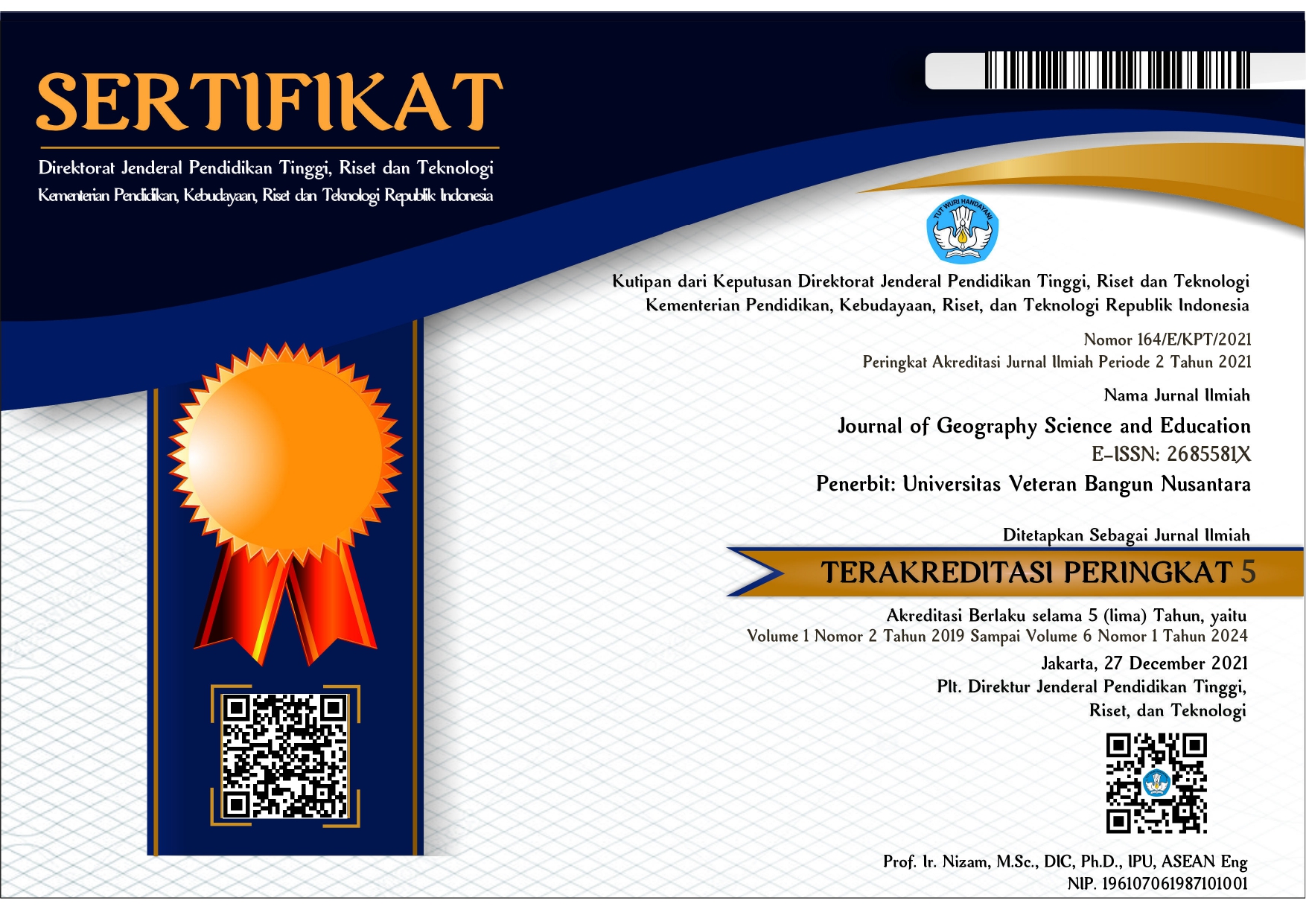AGRICULTURAL LAND SUPPORT FOR FOOD IN GROGOL IN 2018
DOI:
https://doi.org/10.32585/jgse.v3i1.1517Kata Kunci:
agricultural land support, self-sufficiencyAbstrak
Research on the carrying capacity of agricultural land for food is very important to do to determine the extent of the ability of the land to support the fulfillment of food needs of the population in an area. One of the problems in Grogol Subdistrict, Sukoharjo Regency is the tendency of land conversion that does not pay attention to production land for agriculture in order to meet the food needs of the population. This research includes 1 district which consists of 14 villages. The data used is secondary data taken from the Central Bureau of Statistics and the Agriculture Office of Sukoharjo Regency. The method used to determine the level of carrying capacity of agricultural land for food crops with the combined concept of the theory of Odum, Cristeiler, E Howard and Issard. The results showed that overall based on data in 2018 the carrying capacity of agricultural land for food in Grogol District was still low. This shows that the Grogol District area has not been able to be self-sufficient in food and has not been able to provide a decent life for its residents. Therefore, it is necessary to make certain efforts to increase the carrying capacity of food agriculture land in this area, for example by involving the population and utilizing the remaining vacant land.
Unduhan
Referensi
Fitriani, Arie. 2005. Analysis of the Carrying Capacity of Agricultural Land and Population Pressure Case Study in the District of Central Java Province. Sebelas Maret University. Surakarta.
BPS, Grogol, 2019. Grogol District in 2019 Figures. Central Statistics Agency, Grogol.
Kurniawan, A. and Sadali, M. I. 2015. Privileges of the Special Region of Yogyakarta. Yogyakarta: Gadjah Mada University Press.
Moniaga VRB. 2011. Analysis of Agricultural Land Carrying Capacity. ASE Journal. 7 (2): 61-68.https: //doi.org/10.35791/agrsosek.7.2.2011.92
Sadali, M. I. 2016. Worker Mobility in the Piyungan Industrial Area in Bantul Regency, Yogyakarta Special Region. Patrawidya Journal, 17 (3): 83-98. Yogyakarta: Ministry of Education and Culture, Cultural Value Conservation Center, DIY
State Secretariat of the Republic of Indonesia. 1996 Law No.7 of 1996 concerning Food Accessed 02june2020
State Secretariat of the Republic of Indonesia 1996 Law Number 68 of 1996 concerning Food Security Accessed 02 June 2020
Sherly G. Jocom, Celsius Talumingan. 2017. Study of the Supporting Capacity of Agricultural Land to Support Food Self-Sufficiency in South Minhasa District. Volume 13 Number 1, 23 - 36 .: Unsrat,
Fangs, Robinson. 2004. Regional Development Planning. PT. Earth Literacy. Jakarta.
http://www.bulog.co.id/ketahananpangan.php accessed on 02 June 2020
Unduhan
Diterbitkan
Cara Mengutip
Terbitan
Bagian
Lisensi
License and Copyright Agreement
In submitting the manuscript to the journal, the authors certify that:
- They are authorized by their co-authors to enter into these arrangements.
- The work described has not been formally published before, except in the form of an abstract or as part of a published lecture, review, thesis, or overlay journal. Please also carefully read JGSE's Posting Your Article Policy at http://pubs2.ascee.org/index.php/ijele/about/editorialPolicies#custom-5
- That it is not under consideration for publication elsewhere,
- That its publication has been approved by all the author(s) and by the responsible authorities – tacitly or explicitly – of the institutes where the work has been carried out.
- They secure the right to reproduce any material that has already been published or copyrighted elsewhere.
- They agree to the following license and copyright agreement.
Copyright
Authors who publish with Journal of Geography Science and Education agree to the following terms:
- Authors retain copyright and grant the journal right of first publication with the work simultaneously licensed under a Creative Commons Attribution License (CC BY-SA 4.0) that allows others to share the work with an acknowledgment of the work's authorship and initial publication in this journal.
- Authors are able to enter into separate, additional contractual arrangements for the non-exclusive distribution of the journal's published version of the work (e.g., post it to an institutional repository or publish it in a book), with an acknowledgment of its initial publication in this journal.
- Authors are permitted and encouraged to post their work online (e.g., in institutional repositories or on their website) prior to and during the submission process, as it can lead to productive exchanges, as well as earlier and greater citation of published work.
Licensing for Data Publication
Journal of Geography Science and Education use a variety of waivers and licenses, that are specifically designed for and appropriate for the treatment of data:
- Open Data Commons Attribution License, http://www.opendatacommons.org/licenses/by/1.0/ (default)
- Creative Commons CC-Zero Waiver, http://creativecommons.org/publicdomain/zero/1.0/
- Open Data Commons Public Domain Dedication and Licence, http://www.opendatacommons.org/licenses/pddl/1-0/
Other data publishing licenses may be allowed as exceptions (subject to approval by the editor on a case-by-case basis) and should be justified with a written statement from the author, which will be published with the article.
Open Data and Software Publishing and Sharing
The journal strives to maximize the replicability of the research published in it. Authors are thus required to share all data, code or protocols underlying the research reported in their articles. Exceptions are permitted but have to be justified in a written public statement accompanying the article.
The associated persistent identifiers (e.g. DOI, or others) of the dataset(s) must be included in the data or software resources section of the article. Reference(s) to datasets and software should also be included in the reference list of the article with DOIs (where available). Where no domain-specific data repository exists, authors should deposit their datasets in a general repository such as ZENODO, Dryad, Dataverse, or others.
Small data may also be published as data files or packages supplementary to a research article, however, the authors should prefer in all cases a deposition in data repositories.










